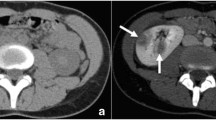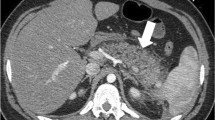Abstract
A review of the literature on the diagnostic accuracy of multidetector computed tomography urography (MDCTU) and intravenous urography (IVU) reveals a lack of comparative studies. However, the available data indicate that MDCTU has a high diagnostic accuracy. MDCTU is also preferred by patients, as it does not require bowel preparation. Full acceptance of this technique by the urologist will depend on optimisation of the communication process with a careful selection of the images to be transmitted. MDCTU has a higher cost than IVU but allows some diagnostic algorithms to be simplified. The real concern potentially limiting the widespread use of MDCTU is its higher radiation dose when compared with IVU. Although low-dose protocols will soon be available, a substantial dose reduction can already be achieved by tailoring MDCTU to the clinical problem rather than using a standardised approach. Our analysis indicates that IVU will definitely lose any residual role it may still have. In our department, the last urographic procedure was performed in May 2006.
Riassunto
L’analisi della letteratura sulla accuratezza diagnostica di uro-TC ed urografia mette in rilievo la scarsità di dati comparativi disponibili. Quanto finora disponibile sottolinea peraltro la notevole efficacia diagnostica dell’uro-TC. L’uro-TC è inoltre preferita dal paziente non necessitando di una preparazione intestinale. La sua piena accettazione da parte dell’urologo inviante dipenderà da una ottimizzazione del processo di comunicazione che passa attraverso una scelta attenta delle immagini da trasmettere. Sotto il profilo economico l’uro-TC presenta un costo superiore all’urografia, ma offre l’opportunità di ottenere consistenti vantaggi economici per la semplificazione di alcuni iter diagnostici. Il vero nodo che può limitare attualmente il ricorso all’uro-TC è rappresentato dalla dose di radiazioni più elevata che tale esame eroga rispetto all’urografia. Ci si sta avviando verso protocolli a bassa dose, ma già ora una riduzione consistente della dose si può ottenere modificando l’effettuazione dell’indagine in base al problema clinico. Tutte queste considerazioni fanno sì che l’urografia possa veder cancellato anche il limitato spazio che ha mantenuto negli ultimi anni. Nel nostro Istituto l’ultimo esame urografico è stato effettuato nel maggio 2006.
Similar content being viewed by others
References/Bibliografia
Van der-Molen A (2006) Extended abstract CTU recommendations. ESUR 2006, Abstract Book, pp 100–106
Dalla Palma L, Morra A, Grotto M (2005) Urografia TC. Radiol Med 110:170–178
Dalla Palma L (2001) What is left of i.v. Urography? Eur Radiol 11:931–939
Nolte-Ernsting C, Cowan N (2006) Understanding multislice CT urography techniques: many roads lead to Rome. Eur Radiol 16:2670–2686
Morcos SK (2007) Computed tomography urography technique, indications and limitations. Curr Opin Urol 17:56–64
Caoili EM, Inampudi P, Cohan RH et al (2005) Optimization of multi-detector row CT urography: effect of compression, saline administration, and prolongation of acquisition delay. Radiology 235:116–123
Chai RY, Jhaveri K, Saini S et al (2001) Comprehensive evaluation of patients with hematuria on a multislice computed tomography scanner: protocol design and preliminary observations. Australas Radiol 45:536–538
Chow LC, Sommer FG (2001) Multidetector CT urography with abdominal compression and three-dimensional reconstruction. AJR Am J Roentgenol 177:849–855
Heneghan JP, Kim DH, Leder RA et al (2001) Compression CT urography: a comparison with IVU in the opacification of the collecting system and ureters. J Comput Assist Tomogr 25:343–347
Huang J, Kim YH, Shankar S et al (2006) Multidector CT urography: comparison of two different scanning protocols for improved visualization of the urinary tract. J Comput Assist Tomogr 30:33–36
Kemper J, Adam G, Nolte-Ernsting CCA (2005) Multislice CT urography: aspects for technical management and clinical indications. Der Radiologe 45:905–914
McNicholas MMJ, Raptopoulos VD, Schwartz RK et al (1998) Excretory phase CT urography for opacification of the urinary collecting system. AJR Am J Roentgenol 170:1261–1267
McTavish JD, Jinzaki M, Zou KH et al (2002) Multi-detector row CT urography: comparison of strategies for depicting the normal urinary collecting system. Radiology 225:783–790
Meindl T, Coppenrath EM, Khaili R et al (2006) MDCT urography: retrospective determination of optimal delay time after intravenous contrast administration. Eur Radiol 16:1667–1674
Silverman SG, Akbar SA, Mortele KJ et al (2006) Multidetector-row CT urography: comparison of furosemide and saline as adjuncts to contrast medium for depicting the normal urinary collecting system. Radiology 240:749–755
Sudakoff GS, Dunn DP, Hellman RS et al (2006) Opacification of the genitourinary collecting system during MDCT urography with enhanced CT digital radiography: non saline versus saline bolus. AJR Am J Roentgenol 186:122–129
Kelsey Fry I, Cattell WR, Spencer AG, Purkiss P (1967) Relation between Hypaque excretion and intravenous pyelogram. BJR 40:572–580
Lang EK, Macchia RJ, Thomas R et al (2003) Improved detection of renal pathologic features on multiphasic helical CT compared with IVU in patients presenting with microscopic hematuria. Urology 61:528–532
Gray Sears CL, Ward JF, Sears ST et al (2002) Prospective comparison of computerized tomography and excretory urography in the initial evaluation of asymptomatic microhematuria. J Urol 168:2457–2460
Caoili EM, Cohan RH, Inampudi P et al (2005) MDCT urography of upper tract urothelial neoplasms. AJR Am J Roentgenol 184:1873–1881
Mc Carthy CL, Cowan NC (2002) Multidetector CT urography (MDCTU) for urothelial imaging. Radiology 225(Suppl):237
Turney BW, Willatt JMG, Nixon D et al (2006) Computed tomography urography for diagnosing bladder cancer. BJU Internat 98:345–348
Amar AD, Das S (1984) Precystoscopic diagnosis of bladder tumors by modified intravenous urography. Br J Urol 56:381–384
Hillman BJ, Silvert M, Cook G et al (1981) Recognition of bladder tumors by excretory urography. Radiology 138:319–323
Grisi G, Stacul F, Cuttin R et al (2000) Cost analysis of different protocols for imaging a patient with acute flank pain. Eur Radiol 10:1620–1627
Caoili EM, Cohan RH, Korobkin M et al (2002) Urinary tract abnormalities: initial experience with multi-detector row CT urography. Radiology 222:353–360
Nawfel RD, Judy PF, Schleipman AR et al (2004) Patient radiation dose at CT urography and conventional urography. Radiology 232:126–132
Spielmann AL, Heneghan JP, Lee LJ et al (2002) Decreasing the radiation dose for renal stone CT: a feasibility study of single and multidetector CT. AJR Am J Roentgenol 178:1058–1062
Coppenrath E, Meindl T, Herzog P et al (2006) Dose reduction in multidetector CT of the urinary tract. Studies in a phantom model. Eur Radiol 16:1982–1989
Author information
Authors and Affiliations
Corresponding author
Rights and permissions
About this article
Cite this article
Stacul, F., Rossi, A. & Cova, M.A. CT urography: The end of IVU?. Radiol med 113, 658–669 (2008). https://doi.org/10.1007/s11547-008-0281-6
Received:
Accepted:
Published:
Issue Date:
DOI: https://doi.org/10.1007/s11547-008-0281-6




